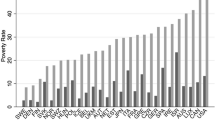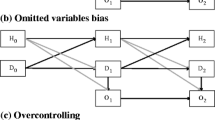Abstract
In this study we examined the additive and multiplicative relations between poverty status, material hardship, liquid assets, non-liquid assets, and children’s cognitive skills and social problems at 36 months. The data were from a representative sample of 1,292 children in six rural counties in the United States. Findings indicated that income, material hardship, and non-liquid assets explained unique variation in young children’s development. Material hardship was associated with more social problems for children. Poverty status was associated with lower cognitive skills, and non-liquid assets were associated with higher cognitive skills at 36 months. We concluded that models that estimate the relation between poverty and child outcomes without including measures of hardship and assets could be underspecified.
Similar content being viewed by others
Explore related subjects
Discover the latest articles and news from researchers in related subjects, suggested using machine learning.References
Brooks-Gunn, J., & Duncan, G. (1997). The effects of poverty on children and youth. The Future of Children, 7, 55–71.
Conger, R. D., & Elder, G. H. (1994). Families and troubled times: Adopting to change in rural America. New York: Aldine de Gruyter.
Conley, D. (2001). Capital for college: Parental assets and postsecondary schooling. Sociology in Education, 74, 59–72.
Dahl, G. B., & Lochner, L. (2005). The impact of family income on child achievement (working paper 11279). Cambridge, MA: NBER.
Dearing, E., McCartney, K., & Taylor, B. A. (2001). Change in family income-to-needs matters more for children with less. Child Development, 72, 1779–1793.
Delobel-Ayoub, M., Kaminski, M., Marret, S., Burguiet, A., Marchand, L., N’Guyen, S., et al. (2006). Behavioral outcome at three years of age in very preterm infants: The EPIPAGE Study. Pediatrics, 117, 1996–2005.
Duncan, G. J., Yeung, W. J., Brooks-Gunn, J., & Smith, J. R. (1998). How much does childhood poverty affect the life chances of children? American Sociological Review, 63, 406–423.
Duncan, G., Ziol-Guest, K. M., & Kalil, A. (2010). Early childhood poverty and adult attainment. Behavior and Health, Child Development, 81, 306–325.
Elliott, W., Jung, H., & Friedline, T. (2010). Math achievement and children’s savings: Implications for child development accounts. Journal of Family and Economics and Issues, 31, 171–184.
Evans, G. W. (2004). The environment of childhood poverty. American Psychologist, 59, 77–92.
Gershoff, E. T. (2003). Low income and hardship among America’s kindergarteners. In Living at the edge (research brief no. 3). New York: National Center for Children in Poverty.
Gershoff, E. T., Aber, J. L., Raver, C. C., & Lennon, M. C. (2007). Income is not enough: Incorporating material hardship into models of income associations with parenting and child development. Child Development, 78, 70–95.
Goodman, R. (2001). Psychometric properties of the Strengths and Difficulties Questionnaire (SDQ). Journal of the American Academy of Child and Adolescent Psychiatry, 40, 1337–1345.
Green, R., & White, M. (1997). Measuring the benefits of homeowning: Effects on children. Journal of Urban Economics, 41, 441–461.
Guo, B. (2011). Household assets and food security: Evidence from the survey of program dynamics. Journal of Family and Economic Issues, 32, 98–110.
Haurin, D., Parcel, T., & Haruin, R. J. (2002). The impact of home ownership on child outcomes. Real Estate Economic, 30, 635–666.
Heckman, J. J. (2008). Schools, skills, and synapses. Economic Inquiry, 46, 289–324.
Holzer, H. (2007). The economic costs of childhood poverty: Testimony before the US House Committee on Ways and Means. Retrieved online from http://www.urban.org/url.cfm?ID=901032.
Iceland, J., & Bauman, K. J. (2007). Income poverty and material hardship. The Journal of Socio-Economics, 36, 376–396.
Kochar, A. (1995). Explaining household vulnerability to idiosyncratic income shocks. The American Economic Review, 85, 159–164.
Magnuson, K., & Vortuba-Drzal, E. (2008). Enduring influences on childhood poverty. Institute or Research on Poverty discussion paper 1348-08. Madison, WI: University of Wisconsin Institute for Research on Poverty.
McLanahan, S. (2004). Diverging destinies: How children are faring under the second demographic transition. Demography, 41, 607–627.
McLoyd, V. C. (1998). Socioeconomic disadvantage and child development. American Psychologist, 52, 185–204.
Mistry, R. S., Vandewater, E. A., Huston, A. C., & McLoyd, V. C. (2002). Economic well being and children’s social adjustment: The role of family process in an ethnically diverse low-income sample. Child Development, 73, 935–951.
Moore, K. A., Vandivere, S., & Redd, Z. (2006). A sociodemographic risk index. Social Indicators Research, 75, 45–81.
Nam, Y., & Huang, J. (2009). Equal opportunity for all? Parental economic resources and children’s educational attainment. Children and Youth Services Review, 31, 625–634.
National Center for Education Statistics (NCES). (2008). Navigating resources for rural schools. Retrieved October 30, 2008 from http://nces.ed.gov/index.asp.
National Research Council and Institute of Medicine (NRCIM). (2000). Executive summary. In J. P. Shonkoff & D. A. Phillips (Eds.), From neurons to neighborhoods: The science of early childhood development (pp. 1–16). Committee on Integrating the Science of Early Childhood Development. Washington, DC: National Academy Press.
Orr, A. J. (2003). Black-white differences in achievement: The importance of wealth. Sociology of Education, 76, 281–304.
Phillips, M., Brooks-Gunn, J., Duncan, G., Klebanov, P., & Craine, J. (1998). Family background, parenting behaviors and the black-white test score gap. In C. Jencks & M. Phillips (Eds.), The black-white test score gap (pp. 229–272). Washington, DC: Brookings Institute.
Ratcliffe, C., Chen, H., Williams Shanks, T. R., Nam, Y., Schreiner, M., Zhan, M., & Sherraden, M. (2007). Assessing asset data on low-income households: Current availability and options for improvement. Part of the series, Poor finances: Assets and low-income households. Washington DC: Urban Institute.
Sattler, J. M. (2001). Assessment of children: Cognitive applications (4th ed.). San Diego: Satter Publisher, Inc.
Save the Children. (2002, June). America’s forgotten children: Child poverty in rural America. Retrieved June 12, 2006, from http://www.savethechildren.org/usa/.
Sayal, K. (2004). The role of parental burdent in child mental health service use: Longitudinal study. Journal of the American Academy of Child and Adolescent Psychiatry, 43, 1328–1333.
Shafer, J. L. & Graham, J. W. (2002). Missing data: Our view of the state of the art. Psychological Methods, 7, 147–177.
Sherraden, M. (2008). IDAs and asset-building: Policy lessons and directions. Center for Social Development working paper no. 08-12. St. Louis, MO: Washington University.
Smith, D. M., Langa, K. M., & Kabeto, M. (2005). Health, wealth, and happiness: Financial resources buffer subjective well-being after the onset of a disability. Psychological Science, 16, 663–666.
Squires, G. D., & Kubrin, C. E. (2005). Privileged places: Race, uneven development and the geography of opportunity in urban America. Urban Studies, 42, 47–68.
Wechsler, D. (2002). Wechsler Preschool and Primary Scale of Intelligence—Third Edition (WPPSI-III). San Antonio: Psychological Corporation.
Williams Shanks, T. R. (2007). The impacts of household wealth on child development. Journal of Poverty, 11, 93–116.
Yeung, J. W., & Conley, D. (2008). African-American achievement gap and family wealth. Child Development, 79, 303–324.
Zhan, M., & Sherraden, M. (2003). Assets, expectations, and children’s educational achievement in female-headed households. Social Service Review, 77, 191–211.
Acknowledgments
Support for this research was provided by the National Institute of Child Health and Human Development Grants R01 HD51502 and P01 HD39667, with co-funding from the National Institute on Drug Abuse.
Author information
Authors and Affiliations
Consortia
Corresponding author
Additional information
The Family Life Project (FLP) Phase I Key Investigators include: Lynne Vernon-Feagans, The University of North Carolina; Martha Cox, The University of North Carolina; Clancy Blair, The Pennsylvania State University; Peg Burchinal, The University of North Carolina; Linda Burton, Duke University; Keith Crnic, The Arizona State University; Ann Crouter, The Pennsylvania State University; Patricia Garrett-Peters, The University of North Carolina; Mark Greenberg, The Pennsylvania State University; Stephanie Lanza, The Pennsylvania State University; Roger Mills-Koonce, The University of North Carolina; Debra Skinner, The University of North Carolina; Emily Werner, The Pennsylvania State University and Michael Willoughby, The University of North Carolina.
Rights and permissions
About this article
Cite this article
Kainz, K., Willoughby, M.T., Vernon-Feagans, L. et al. Modeling Family Economic Conditions and Young Children’s Development in Rural United States: Implications for Poverty Research. J Fam Econ Iss 33, 410–420 (2012). https://doi.org/10.1007/s10834-012-9287-2
Published:
Issue Date:
DOI: https://doi.org/10.1007/s10834-012-9287-2




